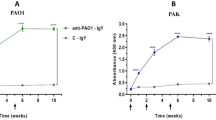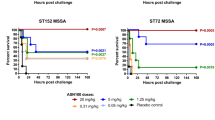Abstract
Purpose. Comparison of the anti-microbial efficacy of locally delivered antibodies in tandem with conventional systemic administration of ceftazidime antibiotic therapy in two lethal gram-negative animal infection models.
Methods. Previously published lethal E. coli-induced closed peritonitis and Klebsiella-induced burn wound infections were generated in outbred female CF-1 mice cohorts. Pooled human polyclonal antibodies were injected locally into sites of infection in these mice simultaneously with intravenous infusions of the broad-spectrum antibiotic, ceftazidime. Mouse survival was compared in sham control cohorts vs. both ceftazidime-alone or antibody-alone systemically infused cohorts as well as local antibody-systemic ceftazidime combination therapy cohorts. Microbial burdens in blood and tissue samples (by agar plating), as well as interleukin-6 cytokine levels (using ELISA) correlated with sepsis, were monitored in sacrificed animals as a function of antimicrobial treatment regimen.
Results. Local delivery of human polyclonal antibodies to infection sites was shown to produce synergistic therapeutic efficacy in combination with systemic antibiotic administration in these lethal wound infection models in mice. Enhanced benefits of the unique combination therapy included host survival, bacterial burden both locally and systemically, and IL-6 levels in host serum.
Conclusions. Commercial pooled human antibodies contain a broad spectrum of antimicrobial activity against gram-negative pathogens. Prevention of systemization of infection correlates with host survival in these models. Local control of infection using doses of local, high-titer polyclonal antibodies can enhance traditional approaches to curb systemic spread of infection using intravenous antibiotics. Antibodies provide antimicrobial efficacy independent of known pathogen resistance mechanisms.
Similar content being viewed by others
REFERENCES
H. C. Neu. The crisis in antibiotic resistance. Science 257:1064–1073 (1992).
H. S. Gold and R. C. Moellering. Antimicrobial-drug resistance. N. Engl. J. Med. 335:1445–1453 (1996).
S. Monroe and R. Polk. Antimicrobial use and bacterial resistance. Curr. Opin. Microbiol. 3:496–501 (2000).
W. Wong and D. L. Pompliano. In B. Rosen and S. Mobashery (eds.), Resolving the antibiotic paradox: progress in drug design and resistance, Plenum, New York, 1999, pp. 1–21.
D. T. Moir, K. J. Shaw, R. S. Hare, and G. F. Vovis. Genomics and antimicrobial drug discovery. Antimicrob. Agents Chemother. 43:439–446 (1999).
A. Persidis. Antibacterial and antifungal drug discovery. Nature Biotechnol. 17:1141–1142 (1999).
J. A. DeVito, J. A. Mills, V. G. Liu, A. Agarwal, C. F. Sizemore, Z. Yao, D. M. Stoughton, M. G. Cappiello, M. D. F. S. Barbosa, L. A. Foster, and D. L. Pompliano. An array of target-specific screening strains for antibacterial discovery. Nature Biotechnol. 20:478–483 (2002).
A. Casadevall. Antibody-based therapies for emerging infectious diseases. Emerg. Infect. Dis. 2:200–208 (1996).
R. H. Buckley and R. I. Schiff. The use of intravenous immune globulin in immunodeficiency diseases. N. Engl. J. Med. 325:110–117 (1991).
C. G. Gemmell. Does the appearance of drug resistance during therapy alter bacterial susceptibility to opsonophagocytosis? Drugs Exp. Clin. Res. 22:51–55 (1996).
A. Cometta, J. D. Baumgartner, and M. P. Glauser. Polyclonal intravenous immune globulin for prevention and treatment of infections in critically ill patients. Clin. Exp. Immunol. 97:69–72 (1994).
G. R. Siber. Immune globulin to prevent nosocomial infections. N. Engl. J. Med. 327:269–271 (1992).
K. N. Haque, C. Remo, and H. Bahakim. Comparison of two types of intravenous immunoglobulins in the treatment of neonatal sepsis. Clin. Exp. Immunol. 101:328–333 (1995).
F. Cafiero, M. Gipponi, U. Bonalumi, A. Piccardo, C. Sguotti, and G. Corbetta. Prophylaxis of infection with intravenous immunoglobulins plus antibiotic for patients at risk for sepsis undergoing surgery for colorectal cancer: results of a randomized, multicenter clinical trial. Surgery 112:24–31 (1992).
K. S. Lamp, M. J. Rybak, B. J. McGrath, and K. K. Summers. Influence of antibiotic and E5 monoclonal immunoglobulin M interactions on endotoxin release from Escherichia coli and Pseudomonas aeruginosa. Antimicrob. Agents Chemother. 40:247–252 (1996).
H. S. El-Zaim, A. K. Chopra, J. W. Peterson, M. L. Vasil, and J. P. Heggers. Protection against exotoxin A (ETA) and Pseudomonas aeruginosa infection in mice with ETA-specific antipeptide antibodies. Infect. Immun. 66:5551–5554 (1998).
J. E. Van Wye, M. S. Collins, M. Baylor, J. E. Pennington, Y. P. Hsu, V. Sampanvejsopa, and R. B. Moss. Pseudomonas hyperimmune globulin passive immunotherapy for pulmonary exacerbations in cystic fibrosis. Pediatr. Pulmonol. 9:7–18 (1990).
R. Malley, J. DeVincenzo, O. Ramilo, P. H. Dennehy, H. C. Meissner, W. C. Gruber, P. J. Sanchez, H. Jafri, J. Balsley, D. Carlin, S. Buckingham, L. Vernacchio, and D. M. Ambrosino. Reduction of respiratory syncytial virus (RSV) in tracheal aspirates in intubated infants by use of humanized monoclonal antibody to RSV F protein. J. Infect. Dis. 178:1555–1561 (1998).
L. B. Rice, E. C. Eckstein, J. DeVente, and D. M. Shlaes. Ceftazidime-resistant Klebsiella pneumoniae isolates recovered at the Cleveland Department of Veterans Affairs Medical Center. Clin. Infect. Dis. 23:118–124 (1996).
J. Wiener, J. P. Quinn, P. A. Bradford, R. V. Goering, C. Nathan, K. Bush, and R. A. Weinstein. Multiple antibiotic-resistant Klebsiella and Escherichia coli in nursing homes. JAMA 281:517–523 (1999).
S. C. Lee, C. P. Fung, P. Y. Liu, T. C. Wang, L. C. See, N. Lee, S. C. Chen, and W. B. Shieh. Nosocomial infections with ceftazidime-resistant Pseudomonas aeruginosa: risk factors and outcome. Infect. Control Hosp. Epidemiol. 20:205–207 (1999).
A. Felts, D. W. Grainger, and J. B. Slunt. Locally delivered antibodies combined with systemic antibiotics confer synergistic protection against antibiotic resistant burn wound infections. J. Trauma 49:873–878 (2000).
N. A. Barekzi, K. A. Poelstra, A. G. Felts, I. A. Rojas, J. B. Slunt, and D. W. Grainger. Efficacy of locally delivered polyclonal immunoglobulin against Pseudomonas aeruginosa peritonitis in a murine model. Antimicrob. Agents Chemother. 43:1609–1615 (1999).
A. G. Felts, G. Giridhar, D. W. Grainger, and J. B. Slunt. Efficacy of locally delivered polyclonal immunoglobulin agains Pseudomonas aeruginosa infection in a murine burn wound model. Burns 25:415–423 (1999).
National Research Council. In N. Grossblatt (ed.), Guide for the Care and Use of Laboratory Animals, National Academy Press, Washington DC, 1996.
P. S. Hiemstra, J. Brands-Tajouiti, and R. van Furth. Comparison of antibody activity against various microorganisms in intravenous immunoglobulin preparations determined by ELISA and opsonic assay. J. Lab. Clin. Med. 123:241–246 (1994).
D. C. Straus. Production of an extracellular toxic complex by various strains of Klebsiella pneumoniae. Infect. Immun. 55:44–48 (1987).
M. S. Collins, R. F. Hector, R. E. Roby, A. A. Edwards, D. K. Ladehoff, and J. H. Dorsey. Prevention of gram-negative and gram-positive infections in rodents with three intravenous immunoglobulins and therapy of experimental polymicrobial burn wound sepsis with Pseudomonas immunoglobulin and ciprofloxacin. Infection 15:S51–S59 (1987).
K. A. Poelstra, N. A. Barekzi, A. M. Rediske, A. G. Felts, J. B. Slunt, and D. W. Grainger. Prophylactic treatment of grampositive and gram-negative abdominal implant infections using locally delivered polyclonal antibodies. J. Biomed. Mater. Res. 60:206–215 (2002).
A. Dalhoff. Synergy between acylureidopenicillins and immunoglobulin G in experimental animals. Am. J. Med. 76:91–100 (1984).
D. R. Absolom, C. J. van Oss, W. Zingg, and A. W. Neumann. Phagocytosis as a surface phenomenon: Opsonization by aspecific adsorption of Antibody as a function of bacterial hydrophobicity. J. Reticuloendothel. Soc. 31:59–70 (1982).
O. Mimoz, A. Jacolot, C. Padoin, J. Caillon, K. Louchahi, M. Tod, K. Samii, and O. Petitjean. Cefepime and amikacin synergy against a cefotaxime-susceptible strain of Enterobacter cloacae in vitro and in vivo. J. Antimicrob. Chemother. 39:363–369 (1997).
Author information
Authors and Affiliations
Corresponding author
Rights and permissions
About this article
Cite this article
Barekzi, N.A., Felts, A.G., Poelstra, K.A. et al. Locally Delivered Polyclonal Antibodies Potentiate Intravenous Antibiotic Efficacy Against Gram-Negative Infections. Pharm Res 19, 1801–1807 (2002). https://doi.org/10.1023/A:1021481122011
Issue Date:
DOI: https://doi.org/10.1023/A:1021481122011




